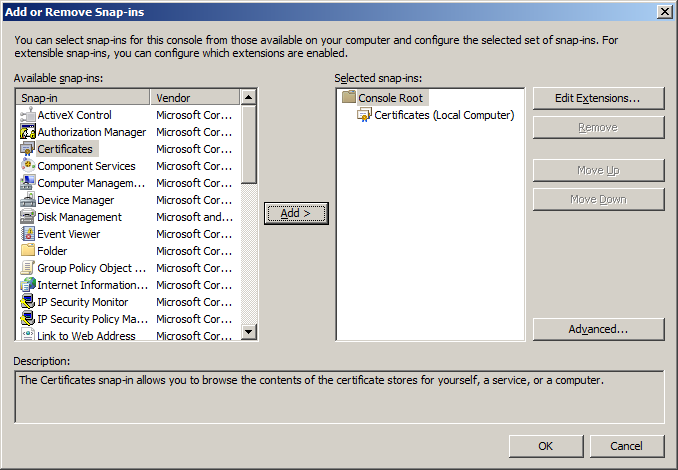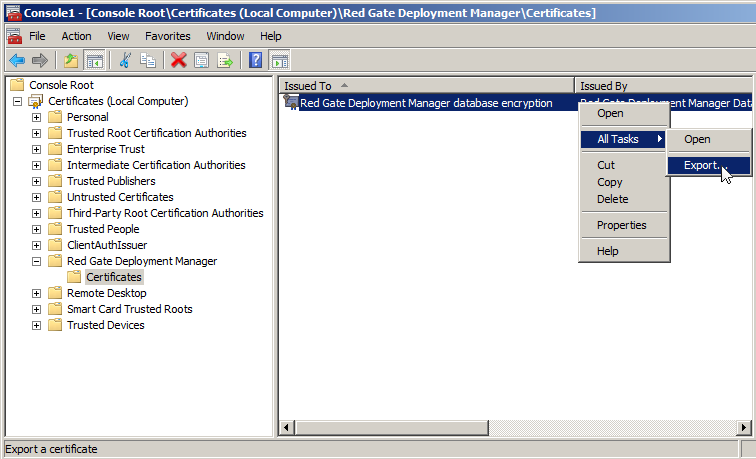Moving Deployment Manager to a different server
Published 24 February 2014
You can move Deployment Manager to a different server. This is useful if you want to move Deployment Manager to a more powerful machine but keep the configuration, data and history of the current installation. For example, you might want to evaluate Deployment Manager on a test machine and then move it onto a production server.
To move Deployment Manager to a new server, do the following:
- Install Deployment Manager on the new server
- Deactivate the serial number on the old server
- Stop the Deployment Manager services on both servers
Export the Red Gate Deployment Manager database encryption certificate from the old server
Import the Red Gate Deployment Manager database encryption certificate to the new server
- Activate the new Deployment Manager server
You'll need administrator rights on both the current Deployment Manager server and on the new server.
If you've installed a local NuGet package feed on the Deployment Manager server, you'll need to move it manually so that you can still access the packages.
If you're using the Deployment Manager package feed, it will be migrated when you copy the Deployment Manager database to the new server. If you're using a remote NuGet package feed or TeamCity server, Deployment Manager will still be able to access it from the new server.
For more information, see Working with package feeds.
Install Deployment Manager on the new server
Install a new copy of Deployment Manager on the new server. You'll then copy across the configuration.
- Download the free Starter Edition of Deployment Manager from the product page.
- Follow the instructions in Installing up to step 10.
Existing user accounts will be moved to the new server; you don't need to set up an administrator account after installing.
If you install a more recent version of Deployment Manager on your new server than you had on your old server, Deployment Manager automatically upgrades the configuration you copy across.
Deactivate the serial number
If you're using Deployment Manager Professional or Enterprise Edition, deactivate the serial number on your old server so you can move it to the new one. Keep a copy of the serial number to enter in the new server later.
To deactivate Deployment Manager:
- In Deployment Manager, go to the Settings page and click Licensing.
- Under Product edition, click Deactivate.
Stop the Deployment Manager services on both servers
To make sure no tasks are in progress while copying the configuration, stop the Red Gate Deployment Manager service on both servers.
- Click the Windows Start button, type services.msc and press Enter.
- In the Services console, click on the Red Gate Deployment Manager service, and on the General tab, click Stop.
Deployment Manager finishes any tasks before stopping the service.
Copy the Deployment Manager database
Deployment Manager uses a RavenDB database to store its configuration, data and history. To move this configuration to the new server, copy the database.
On the new server, locate Deployment Manager's Data folder. This is the location you set on the Database location page of the installer.
The default location is C:\ProgramData\Red Gate\DeploymentManager\DataIf you don't know the location of your Data folder, its path is stored in the Windows registry under HKEY_LOCAL_MACHINE\SOFTWARE\Red Gate\Deployment Manager\Storage.Path- Delete the Data folder from the new server.
- On the old server, locate the the Data folder.
- Copy the Data folder to the new server, to the same location as the folder you deleted.
Export the Red Gate Deployment Manager database encryption certificate
Deployment Manager uses public/private key cryptography to encrypt SQL Server passwords and masked variables in its database so that only the Deployment Manager Windows service can read them. The keys are stored in a certificate named Red Gate Deployment Manager database encryption and kept in the Red Gate Deployment Manager certificate store which is in the Windows Certificate Store.
To move this certificate to the new server, use the Certificates Snap-in for Microsoft Management Console on the old server to export the certificate to a .pfx file. Import this file into the new server.
Set up the Certificates Snap-in in Microsoft Management Console
Click the Windows Start button, type mmc, and press Enter to open Microsoft Management Console.
- In Microsoft Management Console, click File > Add/Remove Snap-in.
The Add or Remove Snap-ins dialog is displayed. - Select Certificates from the list of available snap-ins and click Add.
- Select Computer account and click Next.
- Accept the default: Local computer, and click Finish.
The Certificates snap-in is selected: - Click OK.
Export the certificate
- In the Certificates Snap-in, expand Certificates (Local Computer) > Red Gate Deployment Manager > Certificates
- Right-click the Red Gate Deployment Manager database encryption certificate and click All Tasks > Export:
- Click Next.
- Select Yes, export the private key and click Next.
- Accept the default: Personal Information Exchange - PKCS #12 (.PFX), and click Next.
- Set a password and click Next.
You'll need this password to import the certificate into the new server. - Specify a path and file name for the .pfx file. This file will be created and the certificate will be exported to it. Click Next.
Either create the .pfx file in a location accessible from the new server or copy it to the new server after it's been created. - Review the settings and click Finish.
Import the Red Gate Deployment Manager database encryption certificate
To import the certificate, delete the existing certificate on the new server, then import the .pfx file using the Certificates Snap-in so that it's in the the same location as the previous certificate.
- Make sure the .pfx file exported from the old server is accessible from the new server.
- Open the Certificates Snap-in on the new server (see Set up the Certificates Snap-in in Microsoft Management Console above).
- In the Certificates (Local Computer) > Red Gate Deployment Manager > Certificates folder, right-click the Red Gate Deployment Manager database encryption certificate and click Delete.
- Right-click on the Certificates (Local Computer) > Red Gate Deployment Manager > Certificates folder and click All Tasks > Import.
- Click Next.
Specify the name and path of the .pfx file (see the Export the certificate section above), and click Next.
If you don't select Mark this key as exportable, the import will succeed but you won't be able to export the key if you need to move the server again.
Type the password you set in step 5 of the Export the certificate section above, select Mark this key as exportable and click Next.
- Accept the default: Place all certificates in the Red Gate Deployment Manager certificate store, and click Next.
- Review the settings and click Finish.
Start the Deployment Manager service
- On the new server, click the Windows Start button, type services.msc and press Enter.
- In the Services console, click on the Red Gate Deployment Manager service, and on the General tab, click Start.
Activate Deployment Manager
Use the serial number you deactivated earlier to activate the new Deployment Manager server.
To activate Deployment Manager:
- Log in to the new Deployment Manager with an administrator account.
- On the Settings page, click Licensing.
- Under Serial number, enter the serial number and click Activate.
Check the new Deployment Manager server
Check the Environments, Projects, SQL Servers, target machines and deployment history have successfully been imported from the old server.
The new Deployment Manager server is now ready to use. The old Deployment Manager server can be safely decommissioned.
If you have any problems, contact support.






